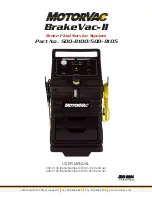
Tips for hydraulic brake bleeding
After installing the correct master cylinder reservoir adapter and connecting the MotorVac BRAKEVAC-II you
can begin the bleeding process. Open one bleeder at a time until the brake fluid flows clean and free of air
bubbles.
To better observe the brake fluid flow and insure cleanliness of the shop we recommend using the MotorVac
‘vacuum’ recovery. This will allow you to observe the fluid color, keep the fluid off the shop floor and allow for
easy fluid disposal.
After a complete hydraulic brake system overhaul we recommend that all bleeders be opened simultaneously
so the air can escape by the path of least resistance. This process eliminates backpressure and the
possibility of the new fluid mixing with contaminated brake fluid remaining in the system. When the fluid
flows clean and free from bubbles, close the bleeder nipples and tighten them one after the other and double
check tightness.
We recommend during this pressure bleeding process to slowly press the brake or clutch pedal a few times
to insure complete purging of air and fluid between the primary and secondary master cylinder chamber.
Fixed calipers can be equipped with multiple bleeder valves, which can require a larger volume of brake fluid.
Each bleeder valve must be bled one after another.
In brake systems with load sensitive brake force regulators, the hydraulic flow to the wheel cylinders may be
restricted when the axles are hanging during lifting. In this case, the axles must be put under load. Consult
manufacture’s repair manual for proper brake bleeding or brake fluid replacement procedures.
Caution:
In brake systems with a
hydraulic
brake booster, the brake system operates with brake fluid and the
hydraulic booster system operates on hydraulic fluid. The two fluids must not be interchanged!
[email protected] www.motorvac.com
5
Suction hose filter assembly
Filter screen must be cleaned routinely to avoid loss of suction.
Elbow part number
030-4814
Filter part number
050-1009
Unscrew cap to
clean filter screen
































